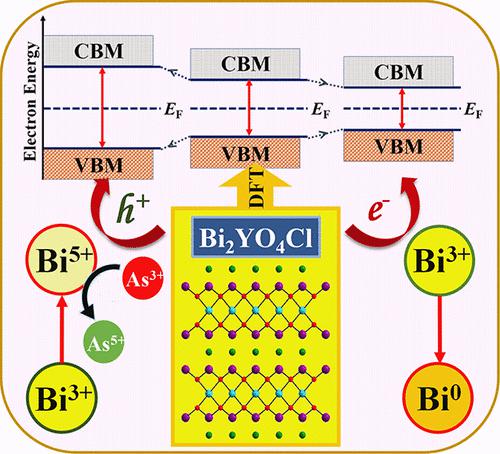当前位置:
X-MOL 学术
›
Inorg. Chem.
›
论文详情
Our official English website, www.x-mol.net, welcomes your
feedback! (Note: you will need to create a separate account there.)
Hole and Electron Doping Outcomes in Bi2YO4Cl
Inorganic Chemistry ( IF 4.3 ) Pub Date : 2023-06-02 , DOI: 10.1021/acs.inorgchem.3c00716 Jyoti Pandey 1 , Neetu Yadav 1 , Priyanka Yadav 1 , Shivangi Rao 1 , Kashmira Malla 2 , Poojan Koirala 2 , Madhav Prasad Ghimire 2, 3 , Rajamani Nagarajan 1
Inorganic Chemistry ( IF 4.3 ) Pub Date : 2023-06-02 , DOI: 10.1021/acs.inorgchem.3c00716 Jyoti Pandey 1 , Neetu Yadav 1 , Priyanka Yadav 1 , Shivangi Rao 1 , Kashmira Malla 2 , Poojan Koirala 2 , Madhav Prasad Ghimire 2, 3 , Rajamani Nagarajan 1
Affiliation

|
Recognizing the deficiency in the hole and electron doping outcomes in layered bismuth-based oxyhalides intergrowths, the current study was addressed to the doping of Ca2+ and Zr4+ for Y3+ in Bi2YO4Cl. The samples were rapidly synthesized by a sol–gel auto combustion method and characterized extensively. Up to 30 mol % Y could be substituted with Ca in tetragonal symmetry and without the appearance of any additional phase. The unit cell parameters varied nonlinearly with the elongation of the Y–O bond. The Raman spectra supported the local site distortion. The calcium-substituted samples displayed selected area electron diffraction characteristics similar to those of Bi2YO4Cl. A blueshift of the absorption edge was noticed with increasing calcium content yielding optical band gap values in the 2.40–2.57 eV range. The creation of 10% Bi5+ in Bi2Y0.70Ca0.30O4Cl was established with the help of XPS measurements and redox titrations. The higher reactivity of Bi5+ in an aqueous solution has been demonstrated for the oxidation of As(III) to As(V). Electron doping through Zr4+ incorporation was possible up to 30 mol % in Bi2YO4Cl. The Y–O bonds are contracted, and the Bi–O bonds are elongated with increasing Zr4+ content. Zr4+’s incorporation induced a local distortion. The color of the sample changed from bright yellow to deep yellow with Zr inclusion, resulting in a progressive decrease in optical band gap values. The introduction of electrons caused the reduction of 13.6% of Bi(III) to Bi(0). These results have established the vulnerability of Bi2O2 chains to charge carriers in Bi2YO4Cl. Density functional theory (DFT) calculations were implemented to understand the electronic and optical properties of the pristine and doped compounds. From the band structure calculations, the chosen compounds were found to be indirect band gap semiconductors. The results of the DFT calculations were in good agreement with the experiment; however, for the doped cases, virtual crystal approximation has been used considering uniform doping at the Y-site.
中文翻译:

Bi2YO4Cl 中的空穴和电子掺杂结果
认识到层状铋基卤氧化物共生中空穴和电子掺杂结果的不足,目前的研究针对在 Bi 2 YO 4 Cl中针对 Y 3+掺杂 Ca 2+和 Zr 4+ 。通过溶胶-凝胶自燃法快速合成样品并进行广泛表征。高达 30 mol% 的 Y 可以以四方对称的形式被 Ca 取代,并且不会出现任何附加相。晶胞参数随 Y-O 键的伸长呈非线性变化。拉曼光谱支持局部站点失真。钙取代样品显示出与 Bi 2 YO相似的选区电子衍射特征4氯。随着钙含量的增加,吸收边发生蓝移,产生 2.40–2.57 eV 范围内的光学带隙值。在 XPS 测量和氧化还原滴定的帮助下,确定了Bi 2 Y 0.70 Ca 0.30 O 4 Cl 中 10% Bi 5+的生成。Bi 5+在水溶液中的较高反应性已被证明可将 As(III) 氧化为 As(V)。在 Bi 2 YO 4 Cl中,通过 Zr 4+掺入的电子掺杂可高达 30 mol% 。随着 Zr 4+含量的增加,Y-O 键收缩,而 Bi-O 键伸长。锆4+的合并引起了局部失真。样品的颜色从亮黄色变为深黄色并夹杂 Zr,导致光学带隙值逐渐减小。电子的引入导致 13.6% 的 Bi(III) 还原为 Bi(0)。这些结果确定了 Bi 2 O 2链对 Bi 2 YO 4中电荷载流子的脆弱性Cl。实施密度泛函理论 (DFT) 计算以了解原始和掺杂化合物的电子和光学特性。从能带结构计算,发现所选择的化合物是间接带隙半导体。DFT计算结果与实验吻合较好;然而,对于掺杂情况,考虑到 Y 位点的均匀掺杂,已使用虚拟晶体近似。
更新日期:2023-06-02
中文翻译:

Bi2YO4Cl 中的空穴和电子掺杂结果
认识到层状铋基卤氧化物共生中空穴和电子掺杂结果的不足,目前的研究针对在 Bi 2 YO 4 Cl中针对 Y 3+掺杂 Ca 2+和 Zr 4+ 。通过溶胶-凝胶自燃法快速合成样品并进行广泛表征。高达 30 mol% 的 Y 可以以四方对称的形式被 Ca 取代,并且不会出现任何附加相。晶胞参数随 Y-O 键的伸长呈非线性变化。拉曼光谱支持局部站点失真。钙取代样品显示出与 Bi 2 YO相似的选区电子衍射特征4氯。随着钙含量的增加,吸收边发生蓝移,产生 2.40–2.57 eV 范围内的光学带隙值。在 XPS 测量和氧化还原滴定的帮助下,确定了Bi 2 Y 0.70 Ca 0.30 O 4 Cl 中 10% Bi 5+的生成。Bi 5+在水溶液中的较高反应性已被证明可将 As(III) 氧化为 As(V)。在 Bi 2 YO 4 Cl中,通过 Zr 4+掺入的电子掺杂可高达 30 mol% 。随着 Zr 4+含量的增加,Y-O 键收缩,而 Bi-O 键伸长。锆4+的合并引起了局部失真。样品的颜色从亮黄色变为深黄色并夹杂 Zr,导致光学带隙值逐渐减小。电子的引入导致 13.6% 的 Bi(III) 还原为 Bi(0)。这些结果确定了 Bi 2 O 2链对 Bi 2 YO 4中电荷载流子的脆弱性Cl。实施密度泛函理论 (DFT) 计算以了解原始和掺杂化合物的电子和光学特性。从能带结构计算,发现所选择的化合物是间接带隙半导体。DFT计算结果与实验吻合较好;然而,对于掺杂情况,考虑到 Y 位点的均匀掺杂,已使用虚拟晶体近似。











































 京公网安备 11010802027423号
京公网安备 11010802027423号